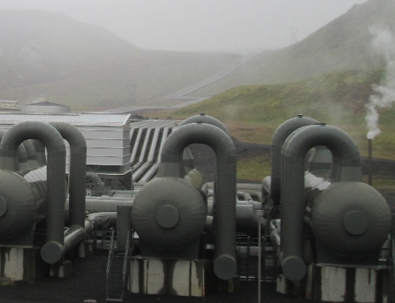Code Green Solutions


Iceland’s location and geology have provided the country with a wealth of natural resources. The island is the size of the state of Kentucky with a population of approximately 325,000, and is located over a hot spot on the Mid-Atlantic Ridge; for this reason, the island has an abundance of naturally-occurring geothermal resources, which have been increasingly utilized for multiple applications. The island is also quite mountainous and gets a considerable amount of precipitation, which has led the country to harness the power of its rivers for hydroelectric power production.
However, the country has not always been a role model of sustainability. Until the mid-20th century, Iceland depended on peat and kerosene for heat and imported coal for electricity. In the wake of the Industrial Revolution in mainland Europe, Iceland began to develop its hydroelectric and geothermal resources in the early 1900s to provide electricity to Reykjavik and to further mechanize the country.
This is the first of a two-part blog covering Icelandic energy infrastructure. Part one will address Iceland’s history of energy generation using geothermal resources.
Geothermal Development
Iceland has a wealth of geothermal resources due to its location, and fields of varying temperatures are scattered across the island (see Figure 1). Early geothermal development in Iceland started with direct use applications, specifically distributed space heating for buildings. In 1908, a farmer living near Reykjavik harnessed the energy from a nearby hot spring to heat his home. In 1930, a pipeline transporting hot water from Thvottalaugar began servicing two schools, a swimming pool, a hospital, and 60 homes. In 1943, the Reykjavik District Heating Service began operations, and served 2,850 homes by the end of 1945. Over the years, distributed space heating, spa, and greenhouse installations proliferated across the country, while the Reykjavik district heating network continued to be expanded.![Figure 2. Fuel Used for Space Heating in Iceland, 1970-2013 Iceland [From ‘Energy Statistics in Iceland 2013', Orkustofnun]](http://insight.gbig.org/wp-content/uploads/2015/01/Figure2-orkustofnun.png)
Figure 2. Fuel Used for Space Heating in Iceland, 1970-2013 Iceland [From ‘Energy Statistics in Iceland 2013′, Orkustofnun]
In the wake of additional support for geothermal development, construction of larger geothermal power facilities progressed, and the Svartsengi and Krafla power plants were commissioned in the late 1970s (Figure 3, numbers 2 and 3). The Svartsengi plant produces both power and heat, supplying the Keflavik airport and four municipalities on the peninsula with hot and cold water and using surplus hot water as supply water for the popular Blue Lagoon spa complex.
Beginning in 1982, conversion of home heating systems from oil or electricity to geothermal was encouraged by subsidizing heating costs for homes heated by electricity and oil and providing grants for residential geothermal heating system installations. These initiatives led to a precipitous decline in the use of non-renewable resources for heating needs.
Throughout the 1980s, the low-temperature fields near Reykjavik were sufficient to supply hot water for the population of the capital, and 83% of the city’s space heating was supplied by the geothermal district heating system. In response to increases in population and demand for hot water, a high-temperature field in the Hengill area was developed and the Nesjavellir cogeneration plant (Figure 3, number 4) began supplying hot water in 1990 and served at least 40% of the capital in 2010. Electricity production began in 1998, and capacity expansions were completed in 2001 and 2005.
![Figure 3. Locations, Capacities, and Production of Iceland's Geothermal Power Plants Iceland [From ‘Energy Statistics in Iceland 2013,' Orkustofnun]](http://insight.gbig.org/wp-content/uploads/2015/01/Figure3-orkustofnun.png)
Figure 3. Locations, Capacities, and Production of Iceland’s Geothermal Power Plants Iceland [From ‘Energy Statistics in Iceland 2013,’ Orkustofnun]
By 2005, 89% of space heating needs in Reykjavik were satisfied by the city’s district heating system. The mid-2000s were a time of construction and expansion of geothermal power plants: the Reykjanes and Hellisheiði power plants (Figure 3, numbers 6 and 7) were constructed in 2006, and additional capacity was added to the Svartsengi and Hellisheiði plants in 2007. In 2008, two new turbines were added to Hellisheiði.
Hellisheiði is a dual flash steam geothermal plant (Figure 4), and has a capacity factor of 87%. In 2010, Hellisheiði became a cogeneration plant, and began supplying hot water to the Reykjavik district heating system. The piping network uses the favorable elevation difference between the plant and the city to minimize pumping energy needed to distribute the hot water to homes in Reykjavik. In 2010, the Reykjavik district heating system served over 204,000 customers, and as of 2011, geothermal resources provided heat for household space heating for 90% of Icelanders.
In 2011, two more turbines were added, making Hellisheiði the largest geothermal power station in Iceland and the world, in terms of installed capacity.
There is currently 664.6 MW of geothermal electrical generation capacity installed in Iceland, the 7th highest capacity in the world. Iceland is also the country with the highest amount of electricity generated per capita. In 2010, the average geothermal field capacity factor was 87%, the highest of any country in the world. In 2013, 29% of electricity produced in Iceland came from geothermal sources.
![Figure 5. Geothermal Energy Utilization in Iceland, 2013 [From 'Energy Statistics in Iceland 2013,' Orkustofnun.]](http://insight.gbig.org/wp-content/uploads/2015/01/Figure5-orkustofnun.png)
Figure 5. Geothermal Energy Utilization in Iceland, 2013 [From ‘Energy Statistics in Iceland 2013,’ Orkustofnun.]
Icelanders have little incentive to save energy, and therefore do not often practice energy efficient behaviors. This can be attributed to the ready availability of inexpensive power and heat. Geothermal heat is abundant and quite cheap, and it is not uncommon for an Icelandic family to keep heaters on year-round; if it gets too hot, they just open the window. Additionally, energy audits for homes are not usually performed, heat pumps are rarely installed, and older buildings with poor insulation are not retrofitted, as it is not worth the financial expense.